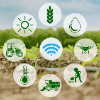With the rapid growth of the Internet of Things (IoT) and a wide range of mobile devices, the conventional cloud computing paradigm faces significant challenges (high latency, bandwidth cost, etc.). Motivated by those constraints and concerns for the future of the IoT, modern architectures are gearing toward distributing the cloud computational resources to remote locations where most end-devices are located. Edge and fog computing are considered as the key enablers for applications where centralized cloud-based solutions are not suitable. In this paper, we review the high-level definition of edge, fog, cloud computing, and their configurations in various IoT scenarios. We further discuss their interactions and collaborations in many applications such as cloud offloading, smart cities, health care, and smart agriculture. Though there are still challenges in the development of such distributed systems, early research to tackle those limitations have also surfaced.
翻译:随着物联网(IOT)的迅速增长和各种移动设备的广泛发展,传统云计算模式面临重大挑战(高潜势、带宽成本等),受这些制约因素和对IOT未来的关切的驱使,现代建筑正致力于将云计算资源分配到大多数终端设备所在的偏远地点。电磁和雾计算被视为不适于集中云基解决方案的应用的关键促进因素。在本文中,我们审查了边缘、雾、云计算及其在各种IOT情景中的配置的高级定义。我们进一步讨论了它们在云卸载、智能城市、医疗保健和智能农业等许多应用中的相互作用与合作。尽管在发展这种分布式系统方面仍然存在挑战,但早期研究也浮现了解决这些限制的面貌。




